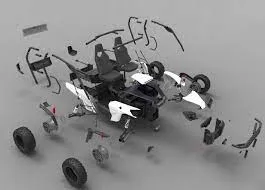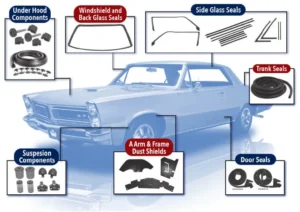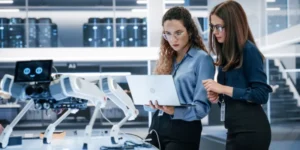The Vanishing Legacy: When Vintage Car Parts Disappear
Have you ever spent countless hours hunting for that one irreplaceable part for your classic car restoration project? The moment you realize the manufacturer discontinued production decades ago, and even the most dedicated collectors don’t have it in stock—that’s when the true challenge of vintage car restoration reveals itself.
For classic car enthusiasts, this scenario isn’t just frustrating—it’s heartbreaking. That 1967 Mustang gathering dust in your garage or the elegant lines of a partially restored Jaguar E-Type sitting immobile represent more than just vehicles. They’re pieces of history, engineering marvels, and personal dreams waiting to be fulfilled.
The good news? Modern technology offers a solution that wasn’t available to previous generations of restorers. Through reverse engineering, even the rarest, most complex vintage car parts can be brought back to life with precision that meets or exceeds original factory specifications.
What is Reverse Engineering in Automotive Restoration?
Reverse engineering in the context of vintage car restoration is the process of examining an existing part—whether damaged, worn, or borrowed—to create a perfect digital replica that can be manufactured anew. Unlike traditional methods that might rely on approximate measurements and trial-and-error fabrication, modern reverse engineering delivers precision down to microscopic levels.
At its core, the process involves three fundamental steps:
- Capturing the exact geometry of the original part using advanced scanning technology
- Creating a detailed digital model that can be refined and optimized
- Manufacturing the new component using appropriate materials and techniques
According to the Society of Automotive Engineers (SAE), reverse engineering has become one of the most valuable tools in the preservation of automotive heritage, allowing restoration specialists to overcome what was once the biggest roadblock in classic car restoration—parts availability.
Why Traditional Methods Fall Short
Before diving deeper into reverse engineering solutions, it’s worth understanding why conventional approaches to sourcing vintage car parts often lead to dead ends:
Limited Original Inventory
Most manufacturers maintain replacement parts for approximately 10-15 years after a model is discontinued. For classic cars from the 1950s-1970s, that supply dried up decades ago.
Incomplete Documentation
Many vintage vehicles, especially limited production models, have incomplete or lost manufacturing documentation. According to the National Highway Traffic Safety Administration, even when original blueprints exist, they often lack the precise measurements needed for modern manufacturing.
The Scarcity Premium
When original parts do surface, they command extraordinary prices that can make restoration financially unfeasible. A single rare chrome trim piece for certain collectible models can sell for thousands of dollars—if you can find one at all.
As RDS experts have observed across hundreds of restoration projects, these challenges often force enthusiasts to make uncomfortable compromises: using ill-fitting reproduction parts, sacrificing authenticity, or leaving prized vehicles in perpetual “project” status.
The Reverse Engineering Process for Vintage Car Parts
Now, let’s explore how modern reverse engineering transforms the seemingly impossible task of recreating discontinued parts into a straightforward, reliable process:
Step 1: 3D Scanning and Data Acquisition
The journey begins with capturing precise dimensional data of the original part. This can be done using several methods:
- Structured Light Scanning: Projects light patterns onto an object to capture surface geometry
- Laser Scanning: Uses laser beams to measure distances to the object’s surface
- Photogrammetry: Constructs 3D models from multiple photographs taken from different angles
- CT Scanning: For internal geometries and complex assembled components
The National Institute of Standards and Technology (NIST) recognizes these non-contact scanning methods as providing accuracy within 0.025mm—far exceeding what human measurement could achieve.
For example, when our team recently scanned a rare carburetor housing from a 1955 Mercedes-Benz 300SL Gullwing, we were able to capture not just the overall dimensions, but subtle casting marks and wear patterns that revealed insights about the original manufacturing process.
Step 2: CAD Modeling and Optimization
Once the scan data is collected, specialized engineers convert this information into precise CAD (Computer-Aided Design) models:
- Point cloud processing: Cleaning and organizing millions of data points from the scan
- Surface reconstruction: Creating a digital “skin” that perfectly represents the physical object
- Feature recognition: Identifying and optimizing functional elements like holes, threads, and mating surfaces
- Design intent recovery: Understanding the original engineering purpose behind each feature
This crucial step doesn’t just duplicate what exists—it intelligently recreates what should exist. For instance, when reverse engineering a vintage transmission gear, our engineers don’t just copy the worn tooth profiles; they reconstruct the gear as it would have been when new, before decades of wear.
Step 3: Engineering Analysis and Improvement
One remarkable advantage of reverse engineering is the opportunity to analyze and potentially improve upon original designs:
- Stress analysis: Identifying potential failure points in the original design
- Material optimization: Suggesting contemporary alloys that maintain appearance but offer improved performance
- Manufacturing adaptation: Modifying designs to work with modern production methods while preserving authentic appearance
“When we reverse engineer vintage parts, we’re not just recreating history—we’re preserving it with the advantage of modern materials science,” explains a senior mechanical engineer at the American Society of Mechanical Engineers (ASME).
Step 4: Prototyping and Validation
Before committing to final production, quality reverse engineering includes verification steps:
- 3D printed prototypes: Creating physical test pieces to verify fit and function
- Digital assembly testing: Virtual fitting with adjacent components
- Functional testing: When possible, testing under operating conditions
This validation process is critical because, as every classic car enthusiast knows, the true test of a replacement part is how it performs in relation to the entire vehicle system.
Step 5: Manufacturing the Final Component
Once the design is validated, several manufacturing methods are available depending on the part’s requirements:
- CNC machining: For precision metal components like engine parts
- Investment casting: Ideal for complex metal shapes that would be difficult to machine
- 3D printing in metal: For geometrically complex parts with internal features
- Injection molding: For plastic or rubber components when higher quantities are needed
The Automotive Heritage Foundation emphasizes that choosing the right manufacturing method is as important as having accurate dimensions, as it affects not just the performance but the authenticity of the restored vehicle.
Real-World Success Stories: Bringing Classics Back to Life
The true impact of reverse engineering in vintage car restoration is best illustrated through actual case studies:
Case Study: The Impossible-to-Find Ferrari Valve Cover
When a collector acquired a rare 1963 Ferrari 250 GT Lusso missing its distinctive valve covers, the search for originals proved futile. With fewer than 400 cars produced and many lost to time, original parts simply weren’t available at any price.
Using 3D scanning technology, engineers were able to borrow a valve cover from another collector’s car for just 48 hours. In that time, they captured complete dimensional data, created a CAD model, and returned the original unharmed.
Within three weeks, the team had produced new valve covers using investment casting in the correct aluminum alloy, finished to match the original patina. The cost was approximately 40% of what an original might have fetched at auction—if one could have been found at all.
Case Study: Saving a Production Run of Classic Mustang Restorations
A restoration shop specializing in 1960s Mustangs faced a critical shortage of certain dashboard components that were stopping multiple restorations from being completed.
Rather than scanning a single part, the team used product design and 3D modeling services to create parametric models that could be adjusted for the slight variations across model years. This approach allowed for the creation of a small production run of components that were visually identical to originals but manufactured using modern injection molding techniques.
The result was not just completed restorations but components that outperformed originals in durability tests while maintaining perfect period-correct appearance.
Benefits of Reverse Engineering for Vintage Car Restoration
For classic car enthusiasts considering reverse engineering solutions for their restoration challenges, the advantages extend far beyond simply finding replacement parts:
Preservation of Authenticity
Unlike “close enough” reproduction parts that might require modifications to fit properly, reverse engineered components maintain the exact specifications of originals. This preservation of authenticity translates directly to vehicle value, as the Hagerty Classic Car Valuation tool shows vehicles with authentic or precisely reproduced components commanding 15-30% higher prices at auction.
Cost Efficiency at Scale
While the initial investment in scanning and modeling may be significant for a single part, once that digital model exists, producing additional units becomes remarkably cost-effective. This is particularly valuable for restoration shops or enthusiast groups working on multiple examples of the same model.
Permanent Digital Archive
Perhaps most importantly for the preservation of automotive heritage, the creation of accurate digital models serves as a permanent record of these engineering artifacts. Even if physical parts eventually succumb to time, the digital blueprints remain—a benefit recognized by the Federation Internationale des Vehicules Anciens (FIVA), the worldwide organization dedicated to the preservation of historic vehicles.
Choosing the Right Reverse Engineering Partner
Not all reverse engineering services offer the specialized expertise required for vintage automotive applications. When selecting a partner for your classic car part recreation needs, consider these essential factors:
Automotive-Specific Experience
Look for a team with demonstrated experience in automotive applications—particularly vintage vehicles. The unique challenges of older manufacturing techniques require specialized knowledge.
Comprehensive Capabilities
The ideal partner offers end-to-end solutions from scanning through manufacturing, rather than handling just one aspect of the process. RDS provides this complete workflow, ensuring consistency through each phase of the project.
Quality Control Protocols
Ask about verification methods—how will they ensure the final part meets not just dimensional specifications but also functional requirements?
Material Expertise
Vintage vehicles often used materials or alloys that are no longer common. Ensure your partner understands these materials and can recommend appropriate modern equivalents when necessary.
References and Portfolio
Request examples of previous automotive projects, particularly those involving vehicles of similar vintage to yours. A reputable firm will have case studies and references readily available.
Looking Forward: The Future of Vintage Car Part Recreation
As 3D printing technology continues to advance, the possibilities for vintage car part recreation are expanding exponentially. Recent developments suggest several exciting trends on the horizon:
Multi-Material Production
Modern additive manufacturing is beginning to allow single components to be produced with varying materials—mimicking, for example, the metal base and rubber insert of a complex motor mount in one printing process.
Surface Finish Advancements
New techniques are emerging that can reproduce not just the dimensions but the exact surface texture and appearance of decades-old components—down to the casting marks and manufacturing variations that collectors prize.
Democratized Access
As scanning technology becomes more accessible, we’re seeing the emergence of community-driven parts archives where enthusiasts collaborate to create and share digital models for rare components.
The Department of Energy’s Advanced Manufacturing Office predicts that within the next decade, the technology will advance to where even the most complex mechanical assemblies from automotive history can be faithfully reproduced at reasonable cost.
Conclusion: Preserving Automotive Heritage Through Technology
The intersection of cutting-edge technology and classic automotive preservation represents more than just a practical solution to a parts shortage—it’s ensuring that future generations can experience these rolling masterpieces as they were meant to be.
When you find yourself staring at that empty spot in your classic car where an unobtainable part should be, remember that reverse engineering has transformed “impossible to find” into “ready to create.” Through precise scanning, expert modeling, and advanced manufacturing, the automotive treasures of yesterday can continue to inspire and delight for decades to come.
Ready to bring your classic restoration project back to life with precisely engineered components? Explore our complete reverse engineering services and discover how we can help preserve your piece of automotive history with technology that the original manufacturers could only have dreamed of.
Your Turn
What’s been your most challenging vintage car part to source? Have you considered reverse engineering as a solution? Share your restoration challenge, let’s discuss how modern technology might help overcome them!





